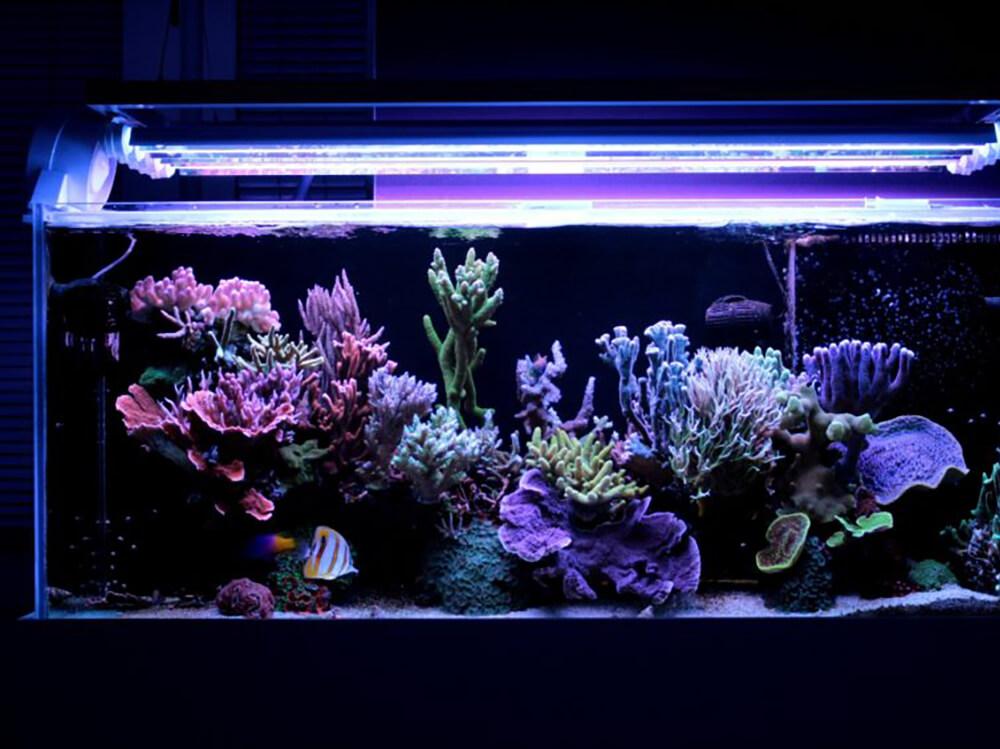How to aquascape a marine aquarium
An effective aquascape is key to a successful reef tank, as it dictates water flow in and around the corals, as well as providing them with places to be anchored.
Get the rockwork right, populate with corals and it can look spectacular.
We used to use predominantly live rock to aquascape marine aquariums. Live rock is reef rock taken from the tropical oceans and brings with it lots of calcareous algae, bacteria and critters. The problem with live rock, however, is that it can bring unwanted hitchhiking pests, and it needs to be kept wet and live, so doesn’t offer much time to arrange and stack it, and once in the water it's harder still.
Use dry rock however and you can take your time arranging the best aquascape while the tank is still bare and dry. This way you can take days or weeks if you want to get the scape just right, putting bits in, taking bits out, and rearranging it.
Dry scaping also means that you can stick rocks together using glue or reef-safe putty and when you glue rocks you can create arches and gravity-defying overhangs, making for a much more impactful scape. Rocks can be chiselled, cut or sawn into shapes and with a little bit of inspiration, you can create a much more natural-looking aquascape that fish and corals will appreciate more too.
Create room around the rocks
It’s usual to create a sloping pile of rocks, leaning against the back glass and inclining up towards the surface at the back. This is ok for coral placement but it takes a lot of rockwork and mulm and debris will build up under the rocks over time. You won’t be able to get to that dirt and it will contribute to nitrate and phosphate levels in the water.
Better still is to leave a border around the rock pile for you to get a gravel vacuum in and around. Pile rocks in the middle of the tank, away from the glass on all sides and with at least a two-inch border that you can get the vacuum tube into. Do this and it will also massively aid water flow around the tank, as strong flow will be able to circle the rockwork, bringing oxygen and food to the corals, washing away their waste, and lifting debris up into the water column for removal via the weir.
Lift the saltwater aquarium rocks up
Better still is to have the minimum amount of rockwork actually touching the base of the aquarium. You can do this by building piles of rocks, only this time with the smallest rocks on the bottom and larger rocks on top.
It takes practice (and is best done outside the tank first,) but by gluing the rock piles together and making an archway or tripod in shape with rock pillars, the whole aquascape can be lifted up on “legs” creating shaded areas underneath for cave-dwelling fish and inverts, while also allowing water to circulate underneath. This works wonders for nutrient control and having all those caves, overhangs and arches looks very much more like a natural coral reef.
Using epoxy putty in reef aquariums
Reefsafe putty can be used underwater but is much more effective if used to bond dry rock and left for 24 hours to cure. Most putties come as two-part, plasticine-like rods, where you cut off equal-sized amounts, mix them thoroughly together in your thumb and forefingers and then place a blob on the rocks. Push another rock into the other side of the blob, make sure it's supported and doesn’t move, and the next day it should be solid.
Get the hang of this and you will be able to create an open, impactful looking rock aquascape, and one which uses less rock (saving money,) versus a standard rock pile. And if you’re worried about the biological capacity of having less rock, don’t be because there are lots of really effective biological media options which will do the biological filtering for you.
How to use cyanoacrylate glue in reef tanks
Cyanoacrylate, also known as SuperGlue Gel, is safe to be used in aquariums, and is used to fix coral frags and plants to plugs, rocks and wood. It is very sticky and will stick your fingers together, so be careful, and practise on something first. If your blob of putty needs a bit more stick you can use glue and putty together, or glue on its own with small rocks and frag plugs. Superglue can also be used underwater and is the fastest sticking method available.
Reef safe concrete for saltwater aquariums
Not ordinary concrete, some aquarium specific types can be used to bond rocks together for aquascapes. It is the most permanent and solid way to bond rocks and is less likely to break its bond if lifting the scape or placing weight on top of it. Wearing gloves, you mix the concrete up, apply it liberally where two rocks meet and within a few seconds a chemical reaction takes place and the rocks are bonded fast. If you get it wrong or don’t apply it correctly it will still go off in seconds and you’d have wasted it, but get it right and the results can be spectacular, with large rocks and plates defying gravity and jutting out into midwater.
How to get a reef tank aquascape cycled
As mentioned above dry rocks don’t come carrying the bacteria that live rocks do, so instead the tank should be filled with saltwater and then beneficial saltwater bacteria should be added. Test the water, stock slowly and build-up livestock over the coming weeks and months.









